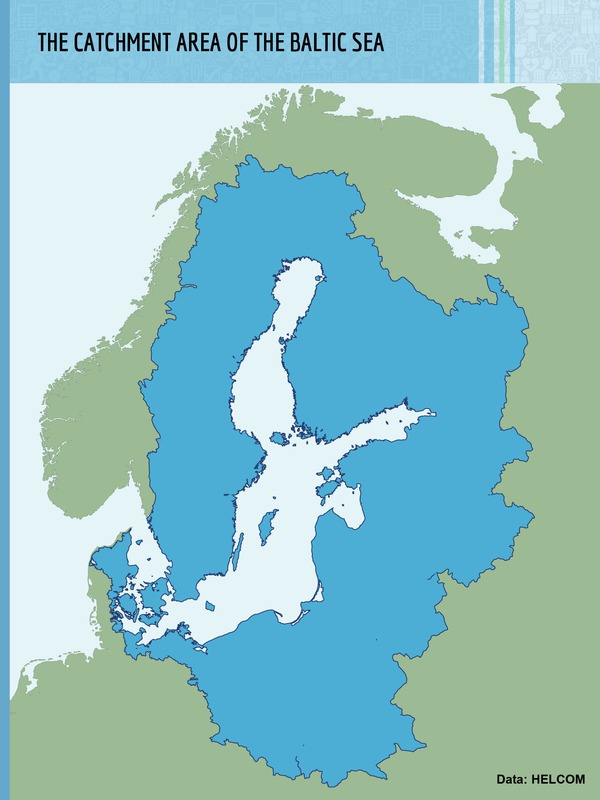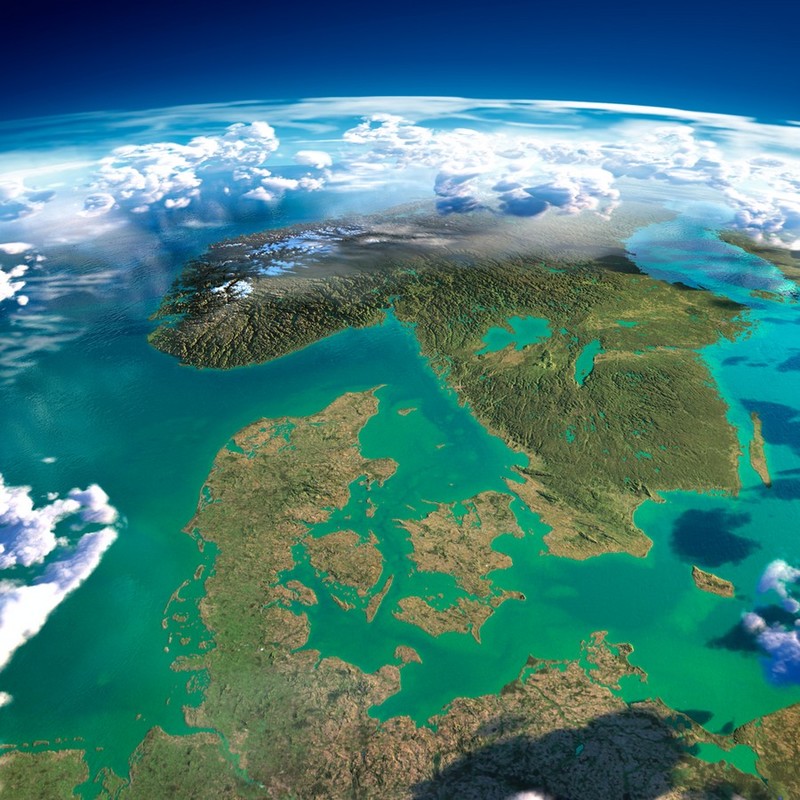12. The Baltic Sea
Contents
12.1 The unique Baltic Sea
 The Baltic Sea is completely unique when compared to all the other seas found on planet Earth.
The Baltic Sea is completely unique when compared to all the other seas found on planet Earth. It is an inland sea, meaning that it is only connected to the oceans via a narrow waterway. Other European inland seas include the Mediterranean and the Black Sea.
The Baltic Sea is uniquely shallow, which is why it contains a relatively small amount of water when compared to other seas. In addition, the bottom of the Baltic Sea does not contain layers of salt found in many other seas and oceans, which is why the Baltic has a very low salt concentration.
The Baltic Sea contains a large number of islands, especially in the archipelagos of Stockholm, Åland and Turku. The Gulf of Bothnia and the Gulf of Finland freeze over during the winter. In addition, the plants and animals of the Baltic Sea are vastly different from those found in other marine regions.
12.2 The salt concentration of the Baltic Sea
 One of the most unique characteristics of the Baltic Sea is its low salt concentration.
One of the most unique characteristics of the Baltic Sea is its low salt concentration.Whereas the salt concentration of the planet's oceans is approximately 3,5 %, the salt concentration of the Baltic Sea is below 1 %. There are many reasons for this difference.
One of the reasons is the large catchment area of the Baltic Sea, which results in salt-free rainwater flowing into the sea from a vast area.
However, the most important cause for the low salt concentration of the Baltic Sea is that it is connected to the planet's oceans only via a narrow waterway. This causes only a small amount of salt-rich ocean water to enter the Baltic Sea.
The salt concentration of the Baltic Sea is highest in the strait of Skagerrak, located between Denmark and Norway. This part of the sea is approximately 700 meters deep, making it the deepest area in the Baltic Sea. When moving towards the center of the Baltic Sea from Skagerrak to the strait of Kattegat, the seafloor rises drastically. In many parts of Kattegat, the water is only 50 meters deep. This causes most of the salt-rich ocean water to remain on the bottom of the Skagerrak strait.
The salt concentration continues to grow lower when moving from Kattegat towards the inner parts of the Baltic Sea. The remaining salt-rich ocean water must pass through the shallow and narrow Danish straits to reach the main pool of the Baltic. After passing through these straits, the salt concentration of the water is only approximately 1 %. After the island of Bornholm, the salt concentration of the Baltic Sea becomes only 0,8 %.
When moving towards the north, the salt concentration continues to decrease, reaching 0,1–0,3 % in the Gulf of Bothnia and the Gulf of Finland.
 The water type of the Baltic Sea is called brackish water. It is a mixture of fresh and salt-rich water. The Baltic Sea receives large amounts of fresh water through the numerous rivers located in its vast catchment area.
The water type of the Baltic Sea is called brackish water. It is a mixture of fresh and salt-rich water. The Baltic Sea receives large amounts of fresh water through the numerous rivers located in its vast catchment area. Because of the low salt concentration in the gulfs of Finland and Bothnia, these parts of the Baltic Sea freeze over more easily than regular seawater. The winter ice poses problems for both humans and the living organisms of the Baltic Sea. For humans, the most important challenge posed by the frozen-over sea is the difficulty it causes for shipping and boat traffic.
The brackish water of the Baltic Sea accomodates fewer species than the planet's oceans do, and the total number of living organisms inhabiting the Baltic Sea is likewise relatively low. However, the organism community of the Baltic Sea is quite unique, consisting of both saltwater and freshwater species.
Different species have adapted to different parts of the Baltic Sea. For example, the starfish and the crab do not survive in the brackish water found in the pool of the Baltic Sea, and they are only found in the straits of Denmark and the southernmost parts of the Baltic Sea, where the salt concentrations are higher.
Some freshwater species also inhabit the Baltic Sea. For example, the vendace can be found in most parts of the Gulf of Bothnia. Overall, freshwater species prefer the low-salt brackish water of the Gulf of Bothnia and Gulf of Finland, whereas saltwater species thrive in the southernmost parts of the Baltic.
12.3 The nature of the Baltic Sea is under threat
As previously discussed, the nature of the Baltic Sea is unique. However, the biodiversity of the Baltic Sea is under threat from many directions.
As the food chains of the Baltic Sea are short and both the number of species and individuals are relatively small, sudden changes in even one species can cause drastic changes in the organism community of the sea. These sudden changes can happen when a species is fished too extensively, for example.
The rivers of the Baltic Sea's catchment area bring fresh water to the sea. However, this water often contains nutrients and pollutants from inland areas. Because of the high amount of nutrients that accumulates in the Baltic, the sea is prone to large growths of algae and cyanobacteria during the summer. These rapid growths cause eutrophication, which is a problem for the organism community of the marine ecosystem. Pollutants and toxic substances from industrial regions also cause damage to the ecosystem of the Baltic Sea.

Cyanobacteria have accumulated near the shore.
During the autumn, a large part of the the Baltic Sea's organism community dies out, and their biomatter begins to be decomposed by bottom-dwelling organisms. When decomposing dead matter, these organisms use up a lot of oxygen, which can often cause a lack of oxygen in the bottom of the sea. In turn, this lack of oxygen further increases the number of dead organisms. When no constant currents exist, oxygen-rich water cannot reach the deepest regions of the Baltic Sea, causing a decay in the organism population of these areas.
The high amount of traffic on the Baltic Sea also causes challenges for its marine ecosystem. Ships and boats often leak waste water or oil into the sea. Although the regulation and control of shipping in the Baltic Sea has become more strict and effective, the sea still receives a fair amount of oil spills, mostly in the form of waste water from oil tankers. The movement of nutrients and toxic substances is also enhanced by the currents caused by ship propellers.

The Baltic Sea usually freezes over during the winter.
In the past, all kinds of waste material were dumped in the rivers that flow to the Baltic Sea. Today, this activity has been almost completely stopped, thanks to various regulations and agreements made by the nations located on the shores of the Baltic. Ship and boat traffic is also regulated more efficiently now than it was before.
 Real-time ship traffic
Real-time ship traffic
As the food chains of the Baltic Sea are short and both the number of species and individuals are relatively small, sudden changes in even one species can cause drastic changes in the organism community of the sea. These sudden changes can happen when a species is fished too extensively, for example.
The rivers of the Baltic Sea's catchment area bring fresh water to the sea. However, this water often contains nutrients and pollutants from inland areas. Because of the high amount of nutrients that accumulates in the Baltic, the sea is prone to large growths of algae and cyanobacteria during the summer. These rapid growths cause eutrophication, which is a problem for the organism community of the marine ecosystem. Pollutants and toxic substances from industrial regions also cause damage to the ecosystem of the Baltic Sea.

Cyanobacteria have accumulated near the shore.
During the autumn, a large part of the the Baltic Sea's organism community dies out, and their biomatter begins to be decomposed by bottom-dwelling organisms. When decomposing dead matter, these organisms use up a lot of oxygen, which can often cause a lack of oxygen in the bottom of the sea. In turn, this lack of oxygen further increases the number of dead organisms. When no constant currents exist, oxygen-rich water cannot reach the deepest regions of the Baltic Sea, causing a decay in the organism population of these areas.
The high amount of traffic on the Baltic Sea also causes challenges for its marine ecosystem. Ships and boats often leak waste water or oil into the sea. Although the regulation and control of shipping in the Baltic Sea has become more strict and effective, the sea still receives a fair amount of oil spills, mostly in the form of waste water from oil tankers. The movement of nutrients and toxic substances is also enhanced by the currents caused by ship propellers.

The Baltic Sea usually freezes over during the winter.
In the past, all kinds of waste material were dumped in the rivers that flow to the Baltic Sea. Today, this activity has been almost completely stopped, thanks to various regulations and agreements made by the nations located on the shores of the Baltic. Ship and boat traffic is also regulated more efficiently now than it was before.